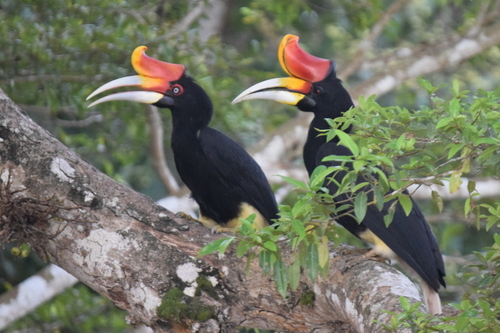
Rhinoceros Hornbill
The Rhinoceros Hornbill (*Buceros rhinoceros*) is a large, striking bird renowned for its enormous, upward-curving casque, resembling a rhinoceros horn. This iconic species plays a crucial ecological role as a seed disperser in the tropical rainforests of Southeast Asia. It holds significant cultural importance for many indigenous communities, often symbolizing strength, power, and the connection between the earthly and spiritual realms. The bird's impressive size, vibrant colors, and unique casque make it a flagship species for conservation efforts in its threatened habitat.
91-122 cm
Length
150-180 cm
Wingspan
Vulnerable
Conservation Status
Distribution
The Rhinoceros Hornbill is found in Southeast Asia, specifically in the Malay Peninsula, Sumatra, Java, and Borneo. It primarily inhabits lowland and hill rainforests, typically up to an altitude of 1,400 meters.
Lifespan
Up to 35 years in the wild, and potentially longer in captivity.
Rhinoceros Hornbill's Habitat
Habitat Types
Primary rainforest, Secondary rainforest, Logged forests (to a limited extent)
Climate Zones
Tropical
Adaptations
Their large, strong bill is adapted for manipulating and consuming fruits, a key component of their diet. The casque, while seemingly cumbersome, is lightweight and may play a role in vocal resonance or species recognition.
Variations
Three subspecies are generally recognized: *B. r. rhinoceros* (Malay Peninsula and Sumatra), *B. r. borneoensis* (Borneo), and *B. r. silvestris* (Java). These subspecies show slight variations in casque size and coloration.
Appearance
Breeding Plumage
There is no significant difference in plumage between breeding and non-breeding seasons.
Seasonal Feather Changes
No significant seasonal variations.
Sex Based Plumage Differences
Males have a larger casque with a more pronounced upward curve and black markings. Females have a smaller, less curved casque and typically have a pale blue or greenish eye-ring, while males have a red eye-ring.
Notable Features
Large, upward-curving casque on top of the bill., Predominantly black plumage with a white belly and tail., White tail feathers with a broad black band., Heavy, powerful bill.
Diet and Feeding
Primary Foods
Fruits (especially figs), Insects, Small vertebrates (lizards, snakes, small birds, rodents)
Foraging Behavior
Rhinoceros Hornbills primarily forage in the forest canopy, using their large bills to pluck fruits and search for prey. They may also descend to the forest floor to feed on fallen fruits or catch small animals.
Specializations
Their strong bill allows them to access a wide variety of fruits, including those with hard shells. They are important seed dispersers, helping to maintain forest diversity.
Seasonal Diet Variations
The proportion of fruit and animal matter in their diet may vary depending on the availability of resources throughout the year. Fruit availability, driven by fruiting seasons, is a major determinant.
Behavior
Social Structure
Rhinoceros Hornbills are generally found in pairs or small family groups. They are not typically found in large flocks.
Communication
Loud, resonant calls, often described as a deep, honking 'hok-hok'., The casque may amplify or modify these vocalizations., Visual displays, such as head-bobbing and bill-clacking.
Migration
Rhinoceros Hornbills are generally non-migratory, remaining within their established territories year-round. However, they may make local movements in response to food availability.
Territorial or Group Behaviors
They are territorial, defending their nesting and foraging areas from other hornbills. Pairs maintain long-term bonds.
Conservation
Threats
Habitat loss (due to deforestation for logging and agriculture), Hunting (for their casques, feathers, and meat), Pet trade (illegal capture of chicks)
Protection Programs
CITES Appendix I (prohibits international trade), Protected areas (national parks and wildlife reserves), Community-based conservation initiatives, Nest-guarding programs
Local National Laws
Protected under national legislation in all range countries.
Population Trend
Decreasing
Population Estimates
Precise population estimates are difficult to obtain, but the species is considered to be declining throughout its range.
Interesting Facts
The casque is made of keratin, the same material as human fingernails.
Despite its size, the casque is relatively lightweight.
The female's self-imprisonment in the nest cavity is a unique adaptation to protect against predators.
This behavior is characteristic of many hornbill species.
Rhinoceros Hornbills are considered culturally significant by many indigenous communities in Borneo.
They are often featured in traditional ceremonies and artwork, and their feathers are used in headdresses.
The loud whooshing sound of their wing beats can be heard from a great distance.
This is due to the lack of underwing coverts, which are feathers that cover the gaps between flight feathers in most birds.
Faqs about Rhinoceros Hornbill
What is the purpose of the hornbill's casque?
The exact function of the casque is not fully understood, but it may play a role in vocal resonance, species recognition, and mate selection. It may also be used in competition between males.
How long does the female hornbill stay inside the nest?
The female remains sealed inside the nest for several months, typically until the chicks are partially grown and ready to fledge.
Are Rhinoceros Hornbills endangered?
The Rhinoceros Hornbill is classified as Vulnerable by the IUCN, meaning it faces a high risk of extinction in the wild.
Can the Rhinoceros Hornbill fly well with such a large casque?
Yes, the casque is surprisingly light and does not significantly hinder their flight. They are strong fliers, capable of navigating through dense forest canopies.
Copyright @ Nature Style Limited. All Rights Reserved.
 English
English